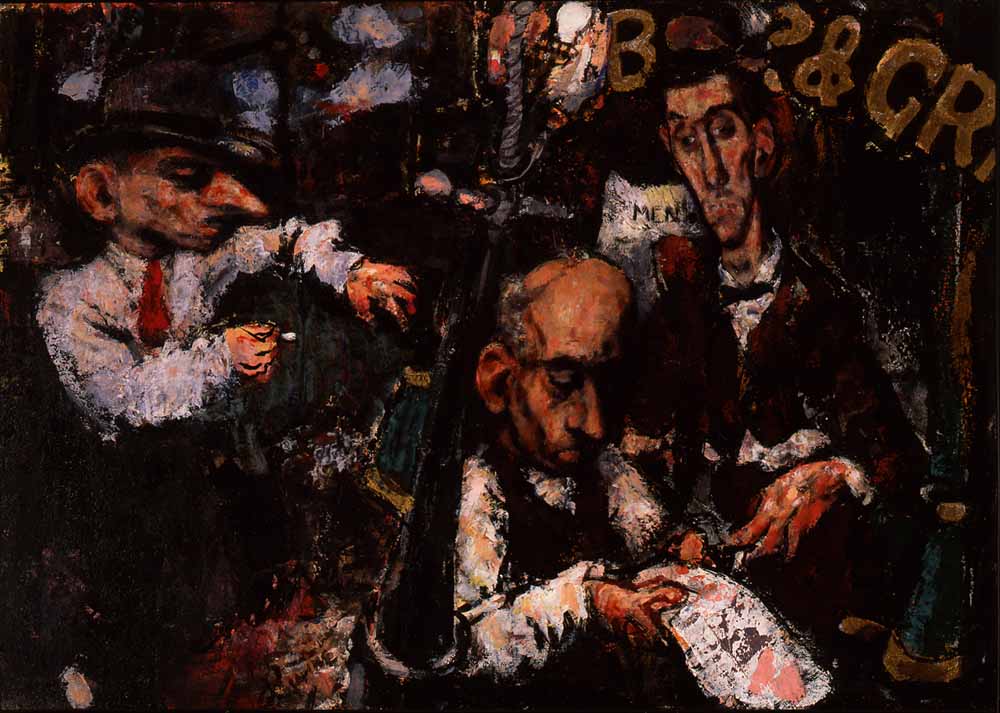
By Bob Hicks
One of the odd things about fame and notoriety is that they freeze people in time, to those moments or years when they were outsized public figures, no matter that they might have eaten breakfast and traveled and read books and made love and voted in the local county commission race and helped fix Thanksgiving dinner with their children for many years afterwards in a state of semi-obscurity. It’s the story Billy Wilder was getting at in Sunset Boulevard, I suppose, although he was more concerned with Norma Desmond’s unhinged inability to deal with her loss of celebrity than in the public’s collective amnesia about her.
The other day my friend John, who’d just been in Kentucky, excitedly showed me a snapshot he’d taken of an oil painting he’d discovered on a distillery wall. It was a Thomas Hart Benton, and a good one, which Benton had painted for the distiller in the early 1950s, a couple of decades after the artist’s brawny regionalist images had set him firmly in the public mind as a sort of Grant Wood with muscles. We were surprised that he’d created such a good and representative piece so late in life — or so we thought, until we looked it up and discovered Benton had lived until 1975, well into the Age of Aquarius. It wasn’t his fault that art and audiences had moved on to other things: He was fixed in our minds as a highly talented 1930s American regionalist.
Then, last night, I discovered while looking through ArtDaily.org that Jack Levine, one of my favorite American painters, had died on Monday at age 95. Here‘s the ArtDaily link, which pairs the Associated Press obituary by Karen Matthews with a good color reproduction of Levine’s wonderful 1946 painting of post-war avarice, Welcome Home. And here is William Grimes’s very good obituary from the New York Times.
Again, I was surprised, because I’d had no idea Levine was still alive. He seemed a figure from an earlier time, a social realist with a strong satiric bent, one of those admirable 1930s and 1940s characters who believed that art had a crucial and very public role to play in the great brawling melodrama of American democracy. Ben Shahn was another.
As it happens, the Portland Art Museum owns a very good early Levine, 1938’s Street Scene #2, a painting I’ve spent a considerable amount of time contemplating during many visits over many years. It’s a scene at a New York City bar and grill, a captured moment that mixes sophistication and pleasure with a lurking uneasiness, a sense that whatever might have been achieved by these three knowing figures in the painting must be measured against an undercurrent of corruption and the possibility of violence, either first-hand or at a bought-and-paid-for businessman’s remove. What price the comforts of civilization? The painting is a temptation and a cautionary tale. More than that, it’s a tremendous, bravura example of painterly swagger and skill.
As Prudence Roberts points out in her brief essay on the painting in the 1996 book Portland Art Museum: Selected Works, Street Scene #2 was included in Levine’s first gallery exhibition, at New York’s Downtown Gallery in 1939. He was 24 years old.
If Levine seemed to lose steam and notice as time wore on, it was partly the fault of his own stubbornness (or fierce consistency, depending on how you look at it). When he returned from World War II he discovered a radically different art world from the one he had left, and he was not amused. Grimes, in his obituary, notes that Levine referred to the ascendant abstract expressionists as “space cadets,” and quotes him on what he thought of the art that followed: “I am alienated from all these movements. They offer me nothing. I think of myself as a dramatist. I look for a dramatic situation, which may or may not reflect some current political social response.”
Grimes, Roberts, and Matthews all quote Levine’s summation of his own work and, in a way, his own life. “I am primarily concerned with the condition of man,” Levine said. “The satirical direction I have chosen is an indication of my disappointment in man, which is the opposite way of saying that I have high expectations for the human race.”
That’s about as good a definition of satire as you’ll ever run across. Without those high expectations, he’d be nothing but a cynic.
*
ILLUSTRATION: Jack Levine, “Street Scene #2,” oil on masonite, 27 x 37.5 inches, 1938. Helen Thurston Ayer Fund, 43.5/Portland Art Museum.